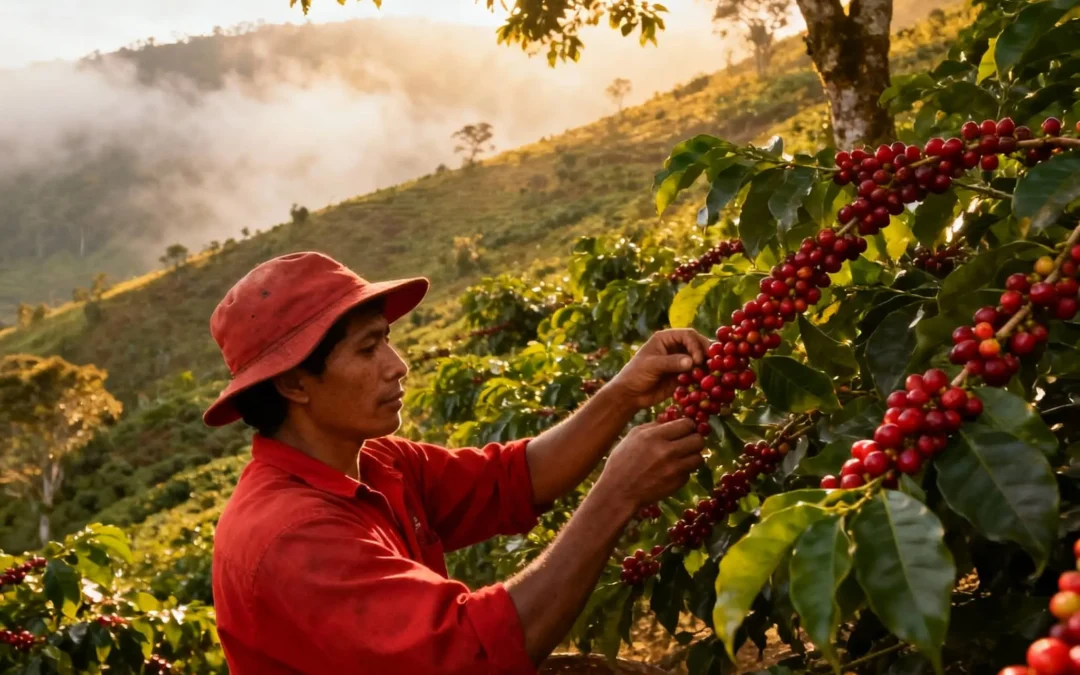Unlocking the secrets of coffee farming — from soil to harvest to market — for sustainable growth and profitable yields
Coffee Farming Uncovered
Coffee farming is a dynamic and rewarding venture when you understand the full cycle — from seed to cup. In this article, we dive into the vital stages of coffee farming, explore key decisions, and show how to build a sustainable and profitable coffee farm that adapts to today’s challenges.
Choosing the Right Coffee Species and Site
When starting coffee farming, the first critical decision is which species of coffee plant to cultivate and where to locate the farm. Two main species dominate commercial production: Coffea arabica (Arabica) and Coffea canephora (Robusta). Arabica accounts for about 60-80 % of global production. Robusta makes up much of the remainder and offers higher caffeine, greater disease resistance, and adaptability to lower altitudes.
In selecting a site, factors like altitude, shade cover, rainfall, soil type, and temperature matter. Historically, Arabica has thrived at higher altitudes with cooler temperatures, while Robusta is planted in warmer, lower-elevation zones. Shade-grown systems support biodiversity and can enhance bean quality, though full sun cultivation delivers higher yields at the cost of increased inputs and environmental impact.
For the aspiring coffee farming entrepreneur, site analysis means measuring slope, soil organic matter, pH, drainage, and access to water. Also consider local climate trends — coffee farming is increasingly sensitive to climate shifts. When you choose your site and species wisely, you set the foundation for consistent yield, bean quality, and long-term sustainability.
In short, the “what” (species) and “where” (site) stage of coffee farming demands careful planning. If you rush into planting without this, you may face poor yields, high inputs, or crop failures. In contrast, deliberate design at this stage gives you a clear path forward in coffee farming that aligns with your market goals and resources.
Establishing a Productive Coffee Farm Layout and Soil Management
With species and site selected, your coffee farming success depends heavily on how you plant, space, and care for your coffee trees, plus how you manage soil health. In coffee farming, tree spacing influences sunlight exposure, airflow (to reduce disease), ease of harvesting, and ultimately bean yield and quality.
Typically, coffee farming uses spacing of several metres between trees, depending on species, terrain, and whether shade trees are used. Incorporating shade trees contributes to coffee farming that is environmentally sustainable: shade-grown coffee can deliver better quality, slower ripening, and more flavour complexity. But balancing shade with productivity is important: too much shade reduces yield and may increase disease risk in coffee farming.
Soil management in coffee farming is another cornerstone. Healthy, well-drained, slightly acidic soils are ideal for Arabica in particular, and adding organic matter (compost, leaf litter) helps retain moisture and nutrients. In many coffee farming systems, farmers rotate crops, integrate legumes, or use cover crops to maintain fertility and reduce erosion. Given that coffee farming often occurs on steep hillsides, erosion control is vital.
In your coffee farming business plan, you should include a planting map: row direction, shade tree placement, access paths for harvest, and water access. Then establish a soil monitoring schedule: pH, nutrient levels, and organic matter. When you get your farm layout and soil right, your coffee farming operation is positioned to reduce inputs, improve tree health, and maximise bean quality.
Harvesting, Processing, and Quality Control in Coffee Farming
In coffee farming, getting the harvest and post-harvest processing right is what turns a crop into a premium product. The general process in coffee farming starts when cherries ripen (often 8 months after flowering for many varieties). Timing of harvest matters: picking cherries at peak ripeness enhances bean quality and removes unripe or overripe fruits, which reduces value.
Processing methods are central in coffee farming. Two main methods dominate: the “wet process” (or washed) and the “dry process” (or natural). In the wet process, the fruit covering the coffee beans is removed before drying, and this method is more water-intensive but often produces cleaner flavours. In the dry process, the whole berry is dried before hulling, as is widely used in some regions, such as the Brazilian example.
Quality control in coffee farming covers sorting, grading, drying to the correct moisture content (often around 10-12 %), storing in good condition, and transporting carefully. Inadequate drying, poor storage, or contamination (mould, off‐flavours) can damage your entire coffee farming outcome. For coffee farming operations aiming at specialty markets, even micro-lots are separated and tracked based on site, variety, and altitude, which lets you command premium prices.
So in your coffee farming strategy, build in harvesting logistics (skilled pickers, cherry selection), processing facilities (washing station, drying beds or mechanical dryers), and quality monitoring (moisture meters, cupping samples). When you integrate these steps systematically, your coffee farming enterprise moves from raw agriculture into a high-value niche.
Exploring Market Channels and Profitability in Coffee Farming
Once your beans are grown and processed, the business side of coffee farming kicks in: market channels, pricing, branding, and profitability. Coffee farming globally is a major source of income: according to broad data, coffee production supports millions of households in developing countries. However, coffee farming also carries risks: volatile global prices, climate impact, input costs, and quality competition.
In coffee farming, when you sell beans, you have choices: commodity markets (bulk green beans), direct trade (selling to roasters with an origin story), specialty markets (single‐estate, certified organic, fair-trade). Each channel demands different quality thresholds and yields different margins. As part of coffee farming planning, you should identify your target market: will you aim for high-margin specialty coffee or volume commodity? This choice affects everything: species, processing investment, quality control, and certification costs.
Another factor for coffee farming profitability is certification and sustainability branding. Buyers increasingly demand sustainability: shade-grown practices, water conservation, and no deforestation. In many producing countries, coffee farming cooperatives pursue certifications (e.g., Rainforest Alliance) to access premium markets. On top of that, coffee farming businesses must watch costs: labour in harvesting, processing capacity, drying infrastructure, storage, and transportation. Even when yields are good, poor logistics can eat margins.
For coffee farming entrepreneurs, monitoring input cost per kilogram, yield per tree, processing loss (cherry to green bean conversion), and market price per kilogram is key. Benchmarking these regularly helps you know whether your coffee farming is viable. With climate change, the margin for error narrows, so a robust marketing plan is essential.
Sustainability, Climate Challenges, and Future of Coffee Farming
As coffee farming enters an era of environmental pressure, understanding the sustainability and resilience dimension is no longer optional. In coffee farming, the crops face threats from temperature increases, shifting rainfall patterns, pests, and diseases. For example, one analysis of Arabica production warns of more than 50% of suitable land being lost by 2050 in some regions.
In coffee farming, sustainable practices include: maintaining shade trees (which moderate micro-climate), improving soil health, diversifying income (intercropping with other crops), using drought-resistant varieties, and reducing chemical inputs. Such practices not only improve coffee farming resilience but also increasingly open access to premium markets demanding ethical sourcing. The adoption of sustainability in coffee farming secures your brand and future in the industry.
Coffee farming also intersects with global regulation. For instance, producers selling into the EU will face requirements to prove their coffee is not linked with deforestation. This means coffee farming must be documented, traceable, and transparent. For your coffee farming enterprise, it’s wise to build record systems now: map your farm, verify that the land wasn’t deforested recently, monitor shade tree cover, and record processing steps. This helps safeguard your market access and ensures the farm remains competitive.
In the coffee farming sector of the future, those who integrate sustainability, quality, resilience, and branding will thrive. A coffee farming operation that ignores these risks may struggle with yield loss, market exclusion, or reduced prices. By focusing on the future now, you secure long-term viability and step into the coffee farming world prepared.
In Conclusion, coffee farming is much more than planting trees—it’s a full system from species selection and farm layout through harvesting, processing, marketing, and sustainability. By treating coffee farming as a business with high-quality standards and future-proof practices, you position yourself to thrive. Take the full journey of coffee farming seriously and you’ll build a resilient, profitable coffee farm that stands the test of time.

